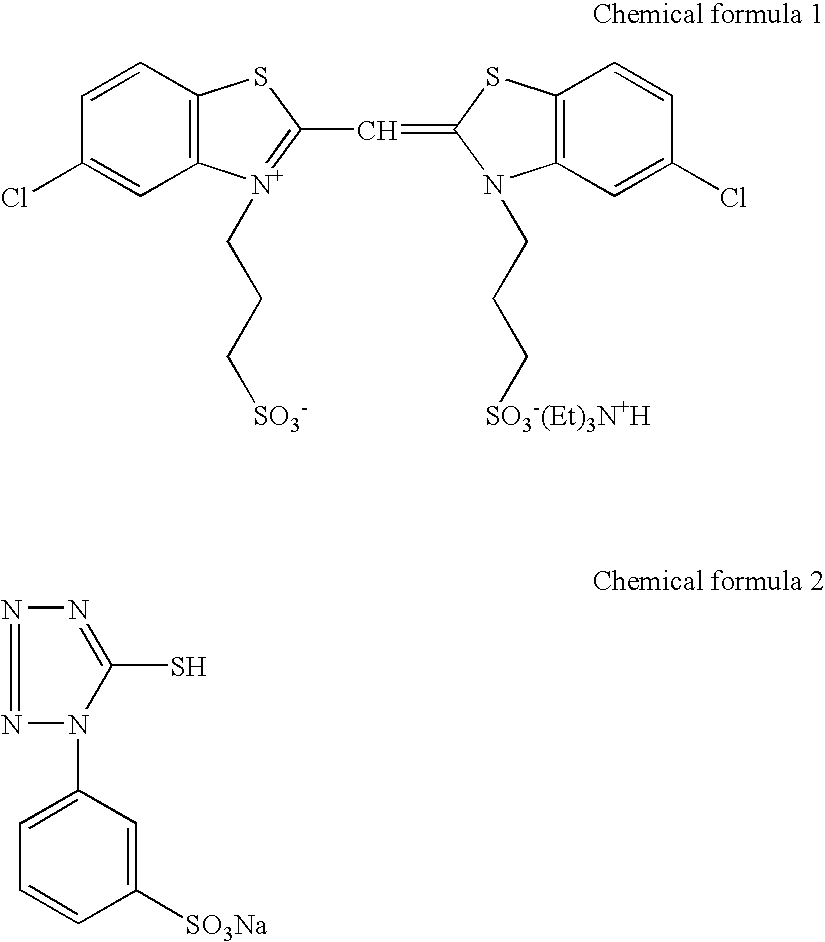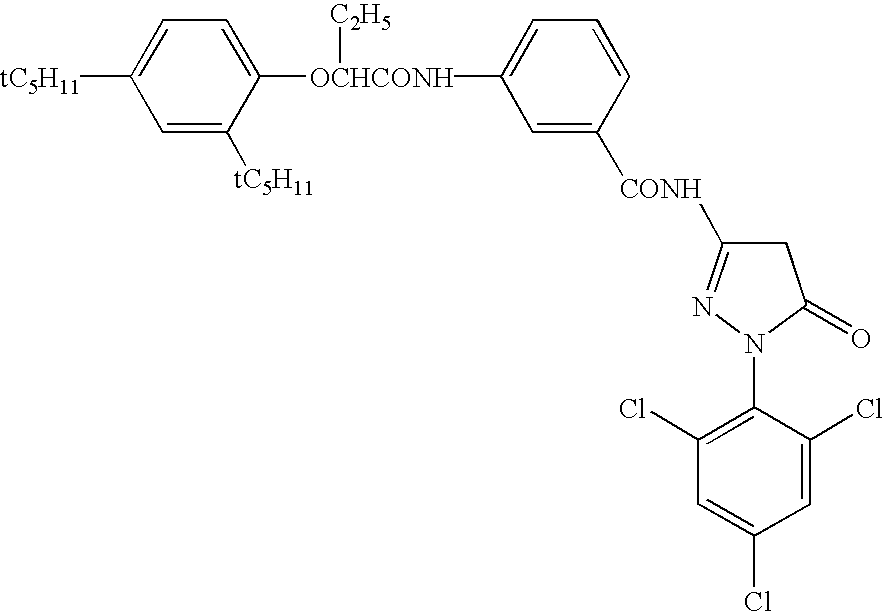Silver halide photographic emulsion and silver halide photographic lightsensitive material using the same
a technology of silver halide and photographic emulsion, which is applied in the direction of photosensitive materials, optics, instruments, etc., can solve the problems of accompanies an increase in grain size, unsatisfactory above-mentioned technologies, and unfavorable mixing of tabular grains other than the above hexagonal tabular grains into the emulsion
- Summary
- Abstract
- Description
- Claims
- Application Information
AI Technical Summary
Benefits of technology
Problems solved by technology
Method used
Image
Examples
example 1
[0191] (Preparation of Emulsion)
[0192] (Seed Emulsion A)
[0193] 1200 mL of an aqueous solution containing 0.9 g of KBr and 3 g of common alkali processed gelatin (average molecular weight: 100 thousand), while maintaining the temperature thereof at 35.degree. C., was agitated (preparation of the 1st solution). 37 mL of aqueous solution Ag-1 (containing 4.9 g of AgNO.sub.3 per 100 mL), 37 mL of aqueous solution X-1 (containing 3.5 g of KBr per 100 mL) and 20 mL of aqueous solution G-1 (containing 2.5 g of the above gelatin per 100 mL) were added thereto at constant flow rates over a period of 30 sec by the triple jet method (Addition 1). An aqueous solution containing 5.2 g of KBr was added, and the temperature of the mixture was raised to 75.degree. C. The mixture was ripened for 9 min, and 200 mL of aqueous solution G-2 (containing 35 g of the above gelatin per 100 mL) was added thereto.
[0194] Subsequently, 162 mL of aqueous solution Ag-2 (containing 14.9 g of AgNO.sub.3 per 100 mL)...
example 2
[0262] Emulsions 1-D', 1-H' and 1-M' furnished with hole trapping zones were prepared in the same manner as in the preparation of the emulsions 1-D, 1-H and 1-M of Example 1, respectively, except that an aqueous solution containing 1.5 g of sodium catecholdisulfonate was added 2 min before the Addition 1 for each of the emulsions and that an aqueous solution containing 0.002 g of thiourea dioxide was added 1 min before the Addition 1 for each of the emulsions. These prepared emulsions were used in coating in the same manner as in Example 1, thereby obtaining samples 201 to 206 specified in the following Table 4. Estimation of the photographic performance thereof was also performed in the same manner as in Example 1. The results are listed in the following Table 4.
10TABLE 4 Ratio of tabular grains satisfying Presence or equivalent-circle absence of diameter .gtoreq.3.0 positive Sample Emulsion .mu.m and aspect hole-capturing name name ratio .gtoreq.8 zone *Sensitivity *Gradient Remar...
example 3
[0264] (Preparation of Emulsion)
[0265] (Em-A)
[0266] 1192 mL of an aqueous solution containing 0.96 g of a low-molecular-weight gelatin and 0.9 g of KBr was vigorously agitated while maintaining the temperature thereof at 40.degree. C. 37.5 mL of an aqueous solution containing 1.49 g of AgNO.sub.3 and 37.5 mL of an aqueous solution containing 1.5 g of KBr were added by the double jet method over a period of 30 sec. 1.2 g of KBr was added and heated to 75.degree. C., and the mixture was ripened. After satisfactory ripening, 30 g of gelatin trimellitate of 100,000 molecular weight obtained by chemically modifying amino groups of gelatin with trimellitic acid was added. Thus, the pH was adjusted to 7.6 mg of thiourea dioxide was added. An aqueous solution of KBr and 116 mL of an aqueous solution containing 29 g of AgNO.sub.3 were added by the double jet method while increasing the flow rate so that the final flow rate was 3 times the initial flow rate. During this period, the silver pot...
PUM
| Property | Measurement | Unit |
|---|---|---|
| equivalent circle diameter | aaaaa | aaaaa |
| aspect ratio | aaaaa | aaaaa |
| equivalent circle diameter | aaaaa | aaaaa |
Abstract
Description
Claims
Application Information
 Login to View More
Login to View More - R&D
- Intellectual Property
- Life Sciences
- Materials
- Tech Scout
- Unparalleled Data Quality
- Higher Quality Content
- 60% Fewer Hallucinations
Browse by: Latest US Patents, China's latest patents, Technical Efficacy Thesaurus, Application Domain, Technology Topic, Popular Technical Reports.
© 2025 PatSnap. All rights reserved.Legal|Privacy policy|Modern Slavery Act Transparency Statement|Sitemap|About US| Contact US: help@patsnap.com



